Ocythoidae
Ocythoe tuberculata
Katharina M. Mangold (1922-2003), Michael Vecchione, and Richard E. YoungIntroduction
This pelagic species occupies near-surface waters (at least at night) in the temperate regions of the world's oceans. The females are large with a mantle length up to 310 mm (Roper and Sweeny, 1976). The mantle is very muscular and the octopod, presumably, is an excellent swimmer. The ventral and dorsal arms are much longer than the lateral arms. Females of Ocythoe are one of the few known cephalopods with a true swimbladder (Packard and Wurtz, 1994) and the only known cephalopods that are ovoviviparous (i.e., give birth to live young that hatch internally) (Naef, 1923). A pair of water pores at the base of the ventral arms lead to extensive water-filled spaces between the eyes and arm bases. In subadult and adult females the ventral surface of the mantle has permanent ridges formimg a reticulate pattern. Males are dwarfs with a mantle length of about 30 mm.

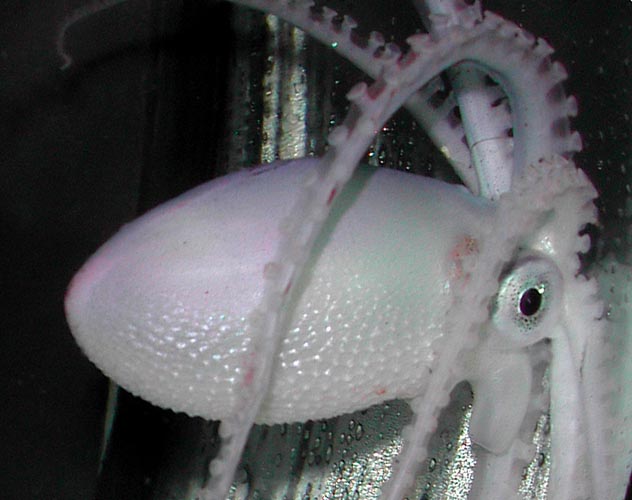
Figure. Lateral view of a young female O. tuberculata, 71 mm ML, in a shipboard aquarium showing ridges and tubercules on the ventral half of the mantle. Photograph by U. Piatkowski, taken aboard the R/V G.O. SARS during the MAR-ECO expedition, 2004, at 50°N, 28°W.
Brief diagnosis:
An argonautoid ...
- with relatively arms II and III much shorter than arms I and IV.
- with reticulate ridge pattern on ventral surface of mantle in females.
Characteristics
- Arms
- Arms II and III much shorter than arms I and IV.
- Hectocotylus (see Comments below)
- Hectocotylus contained in sac extending from base of right arm III in males.
- Hectocotylus lacks papillate lateral fringes.
- Sexual dimorphism
- Males dwarf.
- Males dwarf.
- Head
- Water pores present at base of arms IV in both sexes (see "More details..." below).
- Beaks: Descriptions can be found here: Lower beak; upper beak.
- Radua without greatly reduced first lateral teeth.
- Radula with strong secondary cusp on each first lateral tooth.
- Mantle
- Reticulate pattern of ridges on ventral surface of mantle in females (see photographs above).
- Reticulate pattern of ridges on ventral surface of mantle in females (see photographs above).
- Funnel
- Locking-apparatus formed by permanent, turgid and strongly recurved corners of funnel (see drawing below).
- Locking-apparatus formed by permanent, turgid and strongly recurved corners of funnel (see drawing below).
- Viscera
- Swimbladder present in females (see "More details..." below).
- Swimbladder present in females (see "More details..." below).
- Reproduction
- Ovoviviparous.
Comments
More details about the hectocotylus, water pores and swimbladder can be found here.Nomenclature
A list of all nominal genera and species in the Ocythoidae can be found here. The list includes the current status and type species of all genera, and the current status, type repository and type locality of all species and all pertinent references.
Life history
The eggs develop in the long, winding, distal oviducts until hatching. The egg size is 0.9 X 2 mm and the chorion is drawn out into a hollow stalk even though a stalk no longer has a function (Naef, 1923). Eggs in the oviducts number at least 100,000 in a large female (Naef, 1923). Spawning is intermittent as eggs of various stages of development are present in the oviducts at any one time.

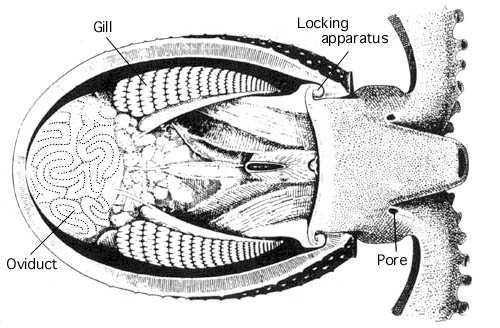
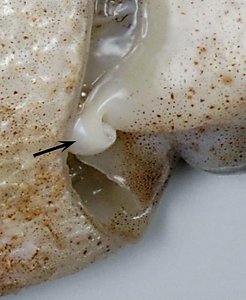
Figure. O. tuberculata. Left - Cut-away drawing of the viscera showing the thick mantle muscle, the long, convoluted, distal oviducts covering the ovary, the strong funnel-mantle locking apparatus and the pores to the water channels. Drawing modified from Naef, 1923. Right - Photograph of the funnel component of the locking apparatus (arrow) (enlargement from title photograph). Photograph by Peter Marriott (NIWA).
Males are dwarfs. Unlike other argonautoids the base of the hectocotylus is free, that is, lies outside (proximal to) the sac holding most of the arm. Males are sometimes found inhabitating the tests of salps as are young females (Naef, 1923; Okutani and Osuga, 1986). Little is known about this relationship.


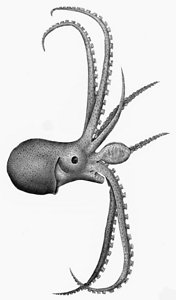
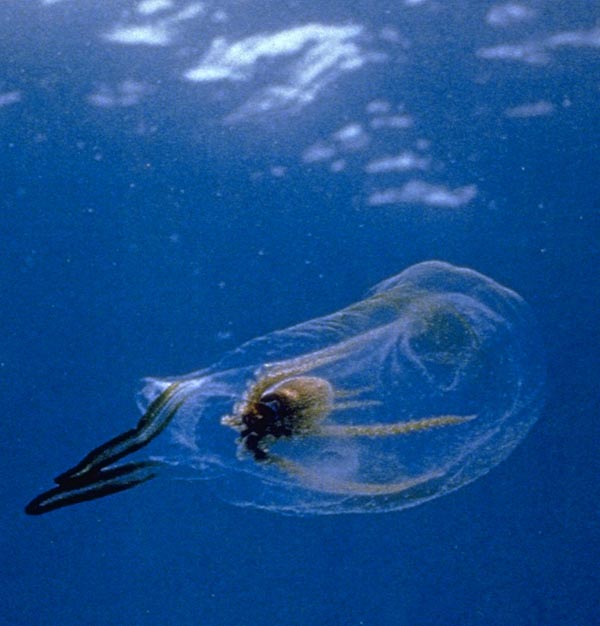

Figure. Lateral views of a young O. tuberculata, apparently a female, residing within the test of the salp, Tethys vagina. Left - Photograph from off Japan a few hundred meters from shore by K. Osuga (published by Okutani and Osuga, 1986, courtesy of T. Okutani). Note that the salp does not seem to be intact. Right - A drawing, made from the photograph, clarifies the position of the octopod within the salp. Drawing from Okutani and Osuga, 1986.
The hatchling is easily identified by the retarded development of the lateral arms which is characteristic of all stages.
Distribution
This species is found throughout the temperate latitudes of the world's oceans (Roper and Sweeny, 1976). This suggest that separate populations exist but the population structure has not been investigated. In the North Pacific large female O. tuberculata have been commonly caught in drift nets set in the upper 10 m of the water at night (M. Seki, pers. comm.); the daytime habitat is unknown.
References
Naef, A. (1921/23). Cephalopoda. Fauna und Flora des Golfes von Neapel. Monograph, no. 35. English translation: A. Mercado (1972). Israel Program for Scientific Translations Ltd., Jerusalem, Israel. 863pp., IPST Cat. No. 5110/1,2.
Okutani, T. and K. Osuga. 1986. A peculiar nesting behavior of Ocythoe tuberculata in the test of a gigantic salp, Tethys vagina. Venus 45: 67-69.
Packard, A. and M. Wurtz. 1994. An octopus, Ocythoe, with a swimbladder and triple jets. Phil. Trans. R. Soc. Lond. B 344: 261-275.
Roper, C. F. E. and M. Sweeny. 1976. The pelagic octopod Ocythoe tuberculata Rafinesque, 1814. Bull. Amer. Malac. Union 1975: 21-28.
Young, R. E. 1972. The systematics and areal distribution of pelagic cephalopods from the seas off Southern California. Smithson. Contr. Zool., 97: 1-159.
Title Illustrations

| Location | Catalina Island off California, U.S.A. |
|---|---|
| Comments | Washed ashore. |
| Sex | Female |
| View | Lateral. |
| Copyright | © 1996 Dorothy Petersen |
| Scientific Name | Ocythoe tuberculata |
|---|---|
| Location | Washed ashore on Catalina Isl., off Southern California |
| Reference | Young, R. E. 1972. The systematics and areal distribution of pelagic cephalopods from the seas off Southern California. Smithson. Contr. Zool., 97: 1-159 |
| Sex | Female |
| Life Cycle Stage | immature |
| View | Ventral |
| Size | 80 mm ML |
| Image Use |
 This media file is licensed under the Creative Commons Attribution-NonCommercial License - Version 3.0. This media file is licensed under the Creative Commons Attribution-NonCommercial License - Version 3.0.
|
| Copyright |
©

|
| Scientific Name | Ocythoe tuberculata |
|---|---|
| Location | New Zealand waters between North and South Islands at 173.5° E, 39.8° S, bottom depth 80 m. |
| Acknowledgements | National Institute of Water & Atmospheric Research (NIWA) |
| Specimen Condition | Fresh |
| Identified By | Darren Stevens (NIWA) |
| Sex | Female |
| View | Ventral |
| Size | 130 mm ML |
| Collection | NIWA |
| Image Use |
 This media file is licensed under the Creative Commons Attribution License - Version 3.0. This media file is licensed under the Creative Commons Attribution License - Version 3.0.
|
| Copyright | © Peter Marriott |
About This Page
Katharina M. Mangold (1922-2003)

Laboratoire Arago, Banyuls-Sur-Mer, France

National Museum of Natural History, Washington, D. C. , USA

University of Hawaii, Honolulu, HI, USA
Page copyright © 2017 Katharina M. Mangold (1922-2003), , and
 Page: Tree of Life
Ocythoidae . Ocythoe tuberculata .
Authored by
Katharina M. Mangold (1922-2003), Michael Vecchione, and Richard E. Young.
The TEXT of this page is licensed under the
Creative Commons Attribution-NonCommercial License - Version 3.0. Note that images and other media
featured on this page are each governed by their own license, and they may or may not be available
for reuse. Click on an image or a media link to access the media data window, which provides the
relevant licensing information. For the general terms and conditions of ToL material reuse and
redistribution, please see the Tree of Life Copyright
Policies.
Page: Tree of Life
Ocythoidae . Ocythoe tuberculata .
Authored by
Katharina M. Mangold (1922-2003), Michael Vecchione, and Richard E. Young.
The TEXT of this page is licensed under the
Creative Commons Attribution-NonCommercial License - Version 3.0. Note that images and other media
featured on this page are each governed by their own license, and they may or may not be available
for reuse. Click on an image or a media link to access the media data window, which provides the
relevant licensing information. For the general terms and conditions of ToL material reuse and
redistribution, please see the Tree of Life Copyright
Policies.
- Content changed 10 October 2017
Citing this page:
Mangold (1922-2003), Katharina M., Michael Vecchione, and Richard E. Young. 2017. Ocythoidae . Ocythoe tuberculata . Version 10 October 2017 (under construction). http://tolweb.org/Ocythoe_tuberculata/20205/2017.10.10 in The Tree of Life Web Project, http://tolweb.org/




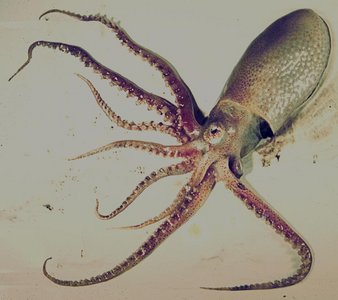

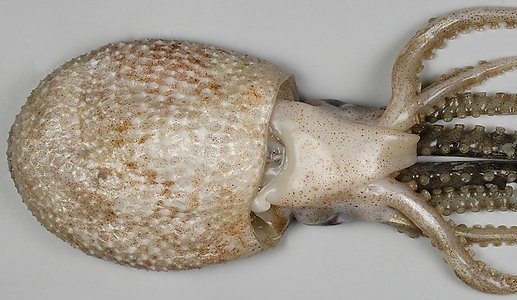
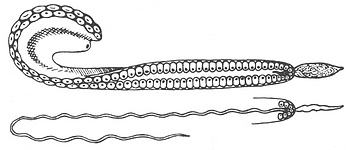
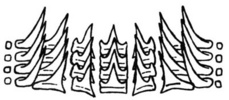
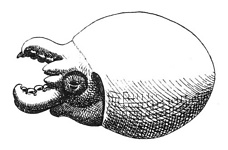


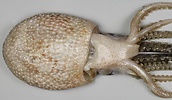


 Go to quick links
Go to quick search
Go to navigation for this section of the ToL site
Go to detailed links for the ToL site
Go to quick links
Go to quick search
Go to navigation for this section of the ToL site
Go to detailed links for the ToL site